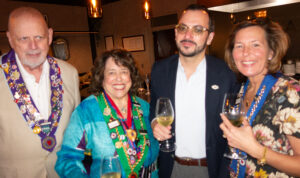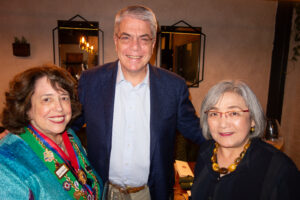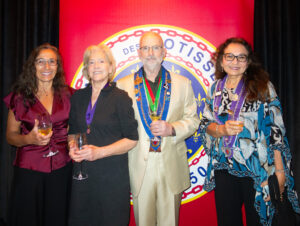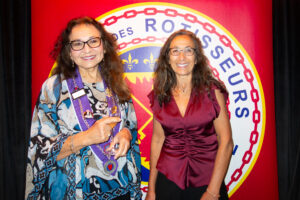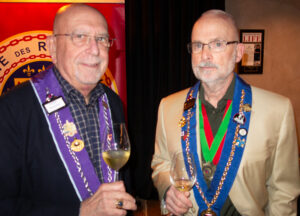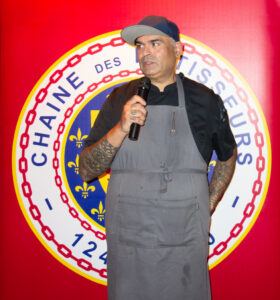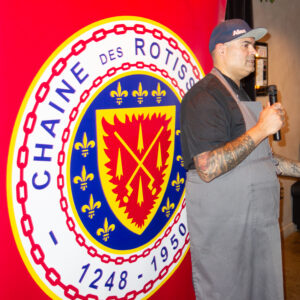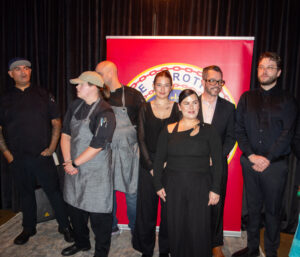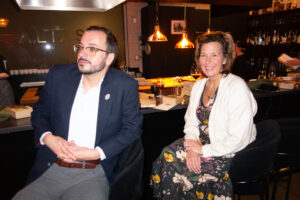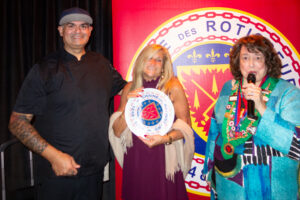Eavesdropping on a Culinary Conspiracy at ALIAS Vint Hill
by Vice Chargé de Presse Wesley J. Jefferies
As the summer twilight hovered over the rolling hills of rural Virginia, the Bailliage of Greater Washington D.C. gathered for at Alias Vint Hill. The setting, an elegantly restored U.S. Army installation turned restaurant and farm, retained a quiet sense of intrigue with its brick walls and soft lighting lending warmth to the evening. Members and guests assembled in the restaurant as dusk embraced the countryside and their conversations threaded easily with the whispering rustle of falling leaves and the gentle pops of corks drawn from bottles on ice.
Vint Hill’s history deepened the evening’s symbolism for a Bailliage in the nation’s capital. Long before the restaurant welcomed the warm glow and murmured chatter of the evening, these same acres served as a nerve center of American intelligence. In 1942, the U.S. Army Signal Corps converted the farm into Vint Hills Farms Station, a secret listening post tuned to German high-frequency transmissions. Its latitude matched Western Europe closely enough to pick up Luftwaffe traffic and one its early intercepts – an encrypted message from Tokyo to Berlin describing Japanese naval tensions – proved critical to the Allied advantage before the attack on Pearl Harbor.
For decades afterwards, the facility remained active throughout the Cold War, eavesdropping on Soviet communications while publicly disguised as an agricultural research site. Only in the 1990s, once the Berlin Wall collapsed and Eastern Europe was liberated, did its existence become widely known. Its bunkers and antenna fields were eventually transformed into wineries, galleries, and – most recently – ALIAS Vint Hill, whose very name is a nod to that historic legacy.
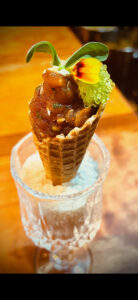
The evening began with members and guests receiving a glass of Von Winning Extra Brut Riesling NV from Germany’s Pflaz region. Aged for 28 months on lees, it showed a crystalline tension and chalky poise, a surprise delight coming from a Riesling, with notes of lemon zest and faint brioche with a sea-spray finish sharpening the palate for the feasts to follow. Plates of hors d’oeuvres gently glided through the room with quiet choreography. A Hawaiian tuna poke tartare arrived on delicate crisps with sea salt, lime, and the raw sweetness of the tuna held in elegant tension while a savory pink peppercorn macaron offered a small, audacious paradox as a gentle chew yielded to a bright, peppered finish. The culminating notes were blinis topped with North Carolina Osetra caviar with its velvety texture and soft sweet brine. The Von Winning Extra Brut Riesling NV’s mineral lift threaded under the tuna tartare, its fine bubbles adding texture to the macaron, and its clear linearity providing a clean frame for the caviar’s gentle saline burst.

As members and guests assumed their places at table, the first course announced itself with a discreet, precise flourish: the Kahlua pork taco assembled with Hawaiian chili pepper, avocado mousse, and lomi tomato – at once an island echo and a chef’s précis with soft smoke tempered by citrus and cool fat. The Jaume Giró i Giró Trepat Brut Rosé NV offered a bright counterpoint with tart cherry and blood orange top notes with a buoyant effervescence. Together, they sang in a miniature duet with heat answered by lift and richness cut by minerality, with its final notes leaving the palate both sated and sharpened.

The Seared Maine Diver Scallop followed, plated with hibiscus mole, roasted corn relish, and smoked salmon roe. The scallop’s caramelized exterior and the mole’s delicate, floral earth chorus demanded a wine of uncommon texture and nuance. A Château Climens “Asphodèle” Grand Blanc Sec 2019, a rare, dry Sémillon from Barsac in southwestern France, arrived prepared for the mission. White peach perfume, river stone minerality, and meadow-grown silk that mirrored the scallop’s tender insides. The pairing was a study in sympathetic restraint with both elements breathing in the same low register, allowing the hibiscus mole to hover without overwhelming.
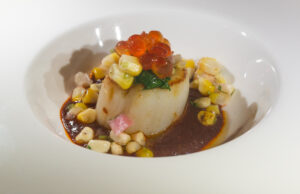
A more contemplative sequence followed with the Chicken and Fig Ballotine. Arrayed with black truffle, fig mousseline, miso-glazed turnips, pickled gooseberries, and a foie-gras demi-glace, the dish threaded sweetness, savory high notes, and fats into a single melody. A Tacchino “Buongiorno” Piemonte Rosso 2019 sang its notes in a dialect matching the dish: the Barbera grape’s plush fruit notes, the Dolcetto’s high-tone lift, and the Nebbiolo’s inner structure provided depth and complexity to the dish. The wine’s cool, disciplined character bestowed tannic shape and aromatic clarity with the fig’s candor and ballotine’s silk finding counterpoint rather than competition.

The main course, a Randell Lineback Beef Short Rib au Poivre, held the room’s attention with a baritone gravitas. Green peppercorn demi-glace, balsamic-glazed baby carrots, and the scatter of freshly shaved black truffles turned the plate into a layered study of density and lift. The dish’s matching proposition, Corazón del Sol Revana Vineyard Cabernet Franc 2022 from Argentina’s Uco Valley, arrived on stage in euphonious harmony with the short rib. The highland fruit notes, limestone-inflected texture, and the varietal’s hallmark peppery and herbal contours presented the palate with a bouquet of raspberry and black-plum folds that gave the short rib’s fat and spice an intricate tannic frame to resolve without bluster in a display of power with a tempered apex.
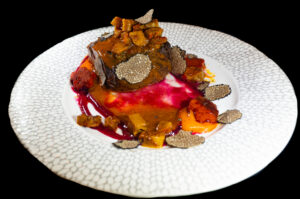
The dulcet tones of a Port Wine poached pear with orange creme fraiche ice cream and a spiced brown sugar fuile provided a melodic coda. The close was deliberate and clean on the palate rather than ornate with each note of the harmony tuned to prolong the finish without the weight. La Cappuccina “Arzimo” Recioto di Soave 2015 answered with the sober luxury of passito Garganega with fig, honey, toasted almond, and a salted-lemon lift that kept sweetness in measure.
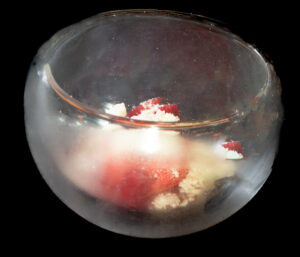
It was in this gentle settling of the evening that Bailli Judith Mazza rose and offered closing reflections that framed the night with the same quiet precision the kitchen had shown in each course. Her welcome, warm but measured, recalled her first visit to ALIAS the previous spring which was an encounter that revealed, to her and to many of the officers, a depth of farm-to-table craft and service that made tonight’s return not merely desirable but inevitable. She acknowledged the distance some had traveled, noting that ALIAS rewarded the journey with an experience that carried both elegance and intention.
The Bailli then turned the room’s attention to Sharon Briskman, present that evening and introduced not simply as an owner but as the animating spirit behind the restaurant’s transformation. Bailli Judith Mazza spoke of Sharon Briskman’s vision with a tone of admiring clarity, inviting her to share the story of the dream that had brought fine dining to this once-secret corner of Virginia.
From there, the Bailli’s remarks widened to honor the officers whose unseen labor had underwritten the evening’s ease. Argentier Stacey Wharam was recognized first for her stewardship of the Bailliage’s accounts described with a respect that acknowledged the hidden complexity of the role and the steadiness with which she carried it. Vice Conseiller Gastronomique Mark Lewonowski was thanked for his deep involvement in the planning of events such as this one, his contributions woven into the very structure of the dinner just enjoyed. Vice Chargé de Missions Juan Loza was noted for his work supporting special projects, with a nod to the expanding demands of that portfolio and to the forthcoming addition of a second Vice Chargé de Missions, Chris Wenstrom, whose absence was marked but whose service was nonetheless honored.
The Bailli then introduced a moment of transition within the Board itself. After many years of dedicated service, Vice Conseiller Gastronomique Mark Lewonowski would be stepping down from his post. His successor, Chevalier Les Fleischer, would assume the role of Gastronomique, bringing a fresh hand to a venerable office. Both Chevalier Les Fleischer and Chris Wenstrom, she noted, would be formally inducted as officers at the Willard on December 16 in a final detail delivered with the ceremonial gravity befitting the close of an evening rooted in heritage, craftsmanship, and the quiet bonds of the table.
With that, the room eased once more into conversation, the night’s final chords settling into memory—an elegant coda to a dinner that had carried the imprint of history, place, and collective care at ALIAS Vint Hill.







